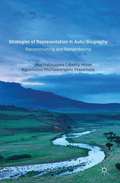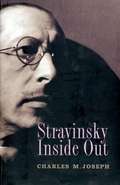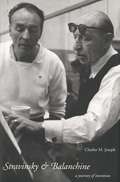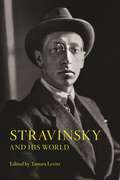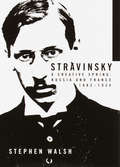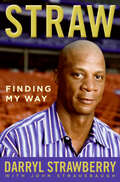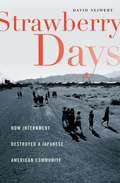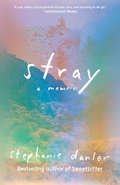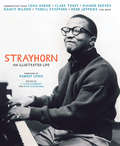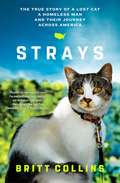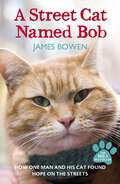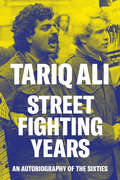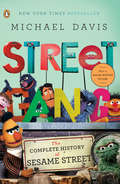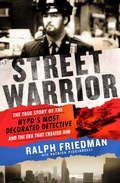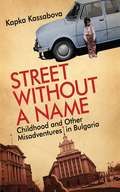- Table View
- List View
Strategies of Representation in Auto/biography
by Muchativugwa Hove Kgomotso MasemolaStrategies of Representation in Auto/biography investigates how selves are represented and reconstructed in selected auto/biographical readings from African literary discourse. It examines how such representations confirm, validate, interrogate and pervade conversations with issues of identity, nation and history. In addition to providing an overview of the multidimensionality of auto/biography, the book also introduces readers to various ways of reading and analysing auto/biographical writings and develops specific perspectives on the genre and views inherently expressed through the re-imagined, re-membered and re-constructed self that speaks through the pages of autobiographical scripting. The focus on auto/biographical writings from southern Africa, specifically South Africa and Zimbabwe, offers a fresh reading of the work of significant figures in the political, economic and sociological spheres of these nation states. This collection shows that auto/biography may be more than simply the representation of an individual life, and that the socio-cultural memory of a people is a core aspect influencing individual self-representation.
Stravinsky Inside Out
by Charles M. JosephRevealing Igor Stravinsky's two sides--the public persona and the private composer--this complex portrait draws upon an array of unpublished materials and rereleased film clips from the composer's huge archive at the Paul Sacher Institute in Switzerland.
Stravinsky and Balanchine: A Journey of Invention
by Charles M. JosephThis book is about the collaboration of some of the greatest artists in the twentieth century, Igor Stravinsky and George Balanchine.
Stravinsky and His World (The Bard Music Festival #33)
by Tamara LevitzA new look at one of the most important composers of the twentith centuryStravinsky and His World brings together an international roster of scholars to explore fresh perspectives on the life and music of Igor Stravinsky. Situating Stravinsky in new intellectual and musical contexts, the essays in this volume shed valuable light on one of the most important composers of the twentieth century.Contributors examine Stravinsky's interaction with Spanish and Latin American modernism, rethink the stylistic label "neoclassicism" with a section on the ideological conflict over his lesser-known opera buffa Mavra, and reassess his connections to his homeland, paying special attention to Stravinsky's visit to the Soviet Union in 1962. The essays also explore Stravinsky's musical and religious differences with Arthur Lourié, delve into Stravinsky's collaboration with Pyotr Suvchinsky and Roland-Manuel in the genesis of his groundbreaking Poetics of Music, and look at how the movement within stasis evident in the scores of Stravinsky's Orpheus and Oedipus Rex reflected the composer's fierce belief in fate. Rare documents—including Spanish and Mexican interviews, Russian letters, articles by Arthur Lourié, and rarely seen French and Russian texts—supplement the volume, bringing to life Stravinsky's rich intellectual milieu and intense personal relationships.The contributors are Tatiana Baranova, Leon Botstein, Jonathan Cross, Valérie Dufour, Gretchen Horlacher, Tamara Levitz, Klára Móricz, Leonora Saavedra, and Svetlana Savenko.
Stravinsky and the Russian Period:
by Pieter C. van den Toorn John McginnessVan den Toorn and McGinness take a fresh look at the dynamics of Stravinsky's musical style from a variety of analytical, critical and aesthetic angles. Starting with processes of juxtaposition and stratification, the book offers an in-depth analysis of works such as The Rite of Spring, Les Noces and Renard. Characteristic features of style, melody and harmony are traced to rhythmic forces, including those of metrical displacement. Along with Stravinsky's formalist aesthetics, the strict performing style he favoured is also traced to rhythmic factors, thus reversing the direction of the traditional causal relationship. Here, aesthetic belief and performance practice are seen as flowing directly from the musical invention. The book provides a counter-argument to the criticism and aesthetics of T. W. Adorno and Richard Taruskin, and will appeal to composers, critics and performers as well as scholars of Stravinsky's music.
Stravinsky and the Russian Traditions, Volume One: A Biography of the Works through Mavra
by Richard TaruskinThis book undoes 50 years of mythmaking about Stravinsky's life in music. During his spectacular career, Igor Stravinsky underplayed his Russian past in favor of a European cosmopolitanism. Richard Taruskin has refused to take the composer at his word. In this long-awaited study, he defines Stravinsky's relationship to the musical and artistic traditions of his native land and gives us a dramatically new picture of one of the major figures in the history of music. Taruskin draws directly on newly accessible archives and on a wealth of Russian documents. In Volume One, he sets the historical scene: the St. Petersburg musical press, the arts journals, and the writings of anthropologists, folklorists, philosophers, and poets. Volume Two addresses the masterpieces of Stravinsky's early maturity—Petrushka, The Rite of Spring, and Les Noces. Taruskin investigates the composer's collaborations with Diaghilev to illuminate the relationship between folklore and modernity. He elucidates the Silver Age ideal of "neonationalism"—the professional appropriation of motifs and style characteristics from folk art—and how Stravinsky realized this ideal in his music. Taruskin demonstrates how Stravinsky achieved his modernist technique by combining what was most characteristically Russian in his musical training with stylistic elements abstracted from Russian folklore. The stylistic synthesis thus achieved formed Stravinsky as a composer for life, whatever the aesthetic allegiances he later professed. Written with Taruskin's characteristic mixture of in-depth research and stylistic verve, this book will be mandatory reading for all those seriously interested in the life and work of Stravinsky.
Stravinsky and the Russian Traditions, Volume Two: A Biography of the Works through Mavra
by Richard TaruskinThis book undoes 50 years of mythmaking about Stravinsky's life in music. During his spectacular career, Igor Stravinsky underplayed his Russian past in favor of a European cosmopolitanism. Richard Taruskin has refused to take the composer at his word. In this long-awaited study, he defines Stravinsky's relationship to the musical and artistic traditions of his native land and gives us a dramatically new picture of one of the major figures in the history of music. Taruskin draws directly on newly accessible archives and on a wealth of Russian documents. In Volume One, he sets the historical scene: the St. Petersburg musical press, the arts journals, and the writings of anthropologists, folklorists, philosophers, and poets. Volume Two addresses the masterpieces of Stravinsky's early maturity—Petrushka, The Rite of Spring, and Les Noces. Taruskin investigates the composer's collaborations with Diaghilev to illuminate the relationship between folklore and modernity. He elucidates the Silver Age ideal of "neonationalism"—the professional appropriation of motifs and style characteristics from folk art—and how Stravinsky realized this ideal in his music. Taruskin demonstrates how Stravinsky achieved his modernist technique by combining what was most characteristically Russian in his musical training with stylistic elements abstracted from Russian folklore. The stylistic synthesis thus achieved formed Stravinsky as a composer for life, whatever the aesthetic allegiances he later professed. Written with Taruskin's characteristic mixture of in-depth research and stylistic verve, this book will be mandatory reading for all those seriously interested in the life and work of Stravinsky.
Stravinsky's Piano
by Graham GriffithsStravinsky's reinvention in the early 1920s, as both neoclassical composer and concert-pianist, is here placed at the centre of a fundamental reconsideration of his whole output – viewed from the unprecedented perspective of his relationship with the piano. Graham Griffiths assesses Stravinsky's musical upbringing in St Petersburg with emphasis on his education at the hands of two extraordinary teachers whom he later either ignored or denounced: Leokadiya Kashperova, for piano and Rimsky-Korsakov, for instrumentation. Their message, Griffiths argues, enabled Stravinsky to formulate from that intensely Russian experience an internationalist brand of neoclassicism founded upon the premises of objectivity and craft. Drawing directly on the composer's manuscripts, Griffiths addresses Stravinsky's lifelong fascination with counterpoint and with pianism's constructive processes. Stravinsky's Piano presents both of these as recurring features of the compositional attitudes that Stravinsky consistently applied to his works, whether Russian, neoclassical or serial and regardless of idiom and genre.
Stravinsky: A Creative Spring: Russia and France, 1882-1934 (New Grove Composer Biographies Ser.)
by Stephen WalshWidely regarded the greatest composer of the twentieth century, Igor Stravinsky was central to the development of modernism in art. Deeply influential and wonderfully productive, he is remembered for dozens of masterworks, from The Firebird and The Rite of Spring to The Rake's Progress, but no dependable biography of him exists. Previous studies have relied too heavily on his own unreliable memoirs and conversations, and until now no biographer has possessed both the musical knowledge to evaluate his art and the linguistic proficiency needed to explore the documentary background of his life--a life whose span extended from tsarist Russia to Switzerland, France, and ultimately the United States.In this revealing volume, the first of two, Stephen Walsh follows Stravinsky from his birth in 1882 to 1934. He traces the composer's early Russian years in new and fascinating detail, laying bare the complicated relationships within his family and showing how he first displayed his extraordinary talents within the provincial musical circle around his teacher, Nikolay Rimsky-Korsakov. Stravinsky's brilliantly creative involvement with the Ballets Russes is illuminated by a sharp sense of the internal artistic politics that animated the group. Portraying Stravinsky's circumstances as an émigré in France trying to make his living as a conductor and pianist as well as a composer while beset by emotional and financial demands, Walsh reveals the true roots of his notorious obsession with money during the 1920s and describes with sympathy the nature of his long affair with Vera Sudeykina.While always respecting Stravinsky's own insistence that life and art be kept distinct, Stravinsky makes clear precisely how the development of his music was connected to his life and to the intellectual environment in which he found himself. But at the same time it demonstrates the composer's remarkably pragmatic psychology, which led him to consider the welfare of his art to be of paramount importance, before which everything else had to give way. Hence, for example, his questionable attitude toward Hitler and Mussolini, and his reputation as a touchy, unpredictable man as famous for his enmities as for his friendships.Stephen Walsh, long established as an expert on Stravinsky's music, has drawn upon a vast array of material, much of it unpublished or unavailable in English, to bring the man himself, in all his color and genius, to glowing life. Written with elegance and energy, comprehensive, balanced, and original, Stravinsky is essential reading for anyone interested in the adventure of art in our time.Praise from the British press for Stephen Walsh's The Music of Stravinsky "One of the finest general studies of the composer."--Wilfrid Mellers, composer, Times Literary Supplement"The beautiful prose of The Music of Stravinsky is itself a fund of arresting images. For those who already love Stravinsky's music, Walsh's essays on each work will bring a smile of recognition and joy at new kernels of insight. For those unfamiliar with many of the works he discusses, Walsh's commentaries are likely to whet appetites for performances of the works."--John Shepherd, Notes"This book sent me scurrying back to the scores and made me want to recommend it to other people. Above all, it is a good read."--Anthony Pople, Music and Letters
Stravinsky: France and America, 1934-1971
by Stephen WalshPicking up where the first volume left off, Walsh, a critic and musicologist at Cardiff U. , continues his biography of Russian composer Igor Stravinsky (1882-1971) from 1934 in France to his death in 1971. The biography follows his life and career from Paris to America, during a time when his wife died, he remarried, composed neoclassical works such as The Rake's Progress and Symphony in C, and dabbled in serialism. The first volume of the biography is Stravinsky: A Creative Spring: Russia and France, 1882-1934, which was published in 1999. Annotation ©2006 Book News, Inc. , Portland, OR (booknews. com)
Straw: Finding My Way
by Darryl Strawberry John Strausbaugh“Darryl has written a profound book on the meaning of celebrity, sports and manhood . . . a riveting and memorable account.” —David ConeFormer New York Met and Yankee slugger Darryl Strawberry has subtitled his autobiography Straw, “Finding My Way”—and his path was never easy. A National League Rookie of the Year, eight-time MLB All Star, and four-time World Series Champion, Strawberry’s baseball achievements were often overshadowed by his struggles off the field. In Straw, he tells it all: his boyhood in Crenshaw, Los Angeles; his rise to baseball superstardom; the high life and low life; his brushes with the law; his triumphant battle over cancer; his religious awakening, and his marriage to the love of his life.“Straw is the story of a guy who had two strikes against him in the middle innings of life and hit one out of the park.” —Reggie Jackson“Straw [has] the virtue of sincerity and of seeming profoundly felt. Its narrator emerges as a real and complex man: humble in the face of his failures, palpably hungry for redemption, and yet still capable of myopia and self-righteousness. You feel for him in a way you never did—at least I never did—when you were merely cheering and/or booing him at Shea.” —The New York Times“If you’re looking for an interesting book about a chaotically interesting life, Straw makes for good reading.” —St. Louis Post-Dispatch
Strawberry Days: How Internment Destroyed a Japanese American Community
by David A. NeiwertImmigrants from Japan began coming to the west coast of the United States toward the end of the 19th century. Along the eastern shore of Lake Washington a community of farmers became highly successful, raising strawberries and an assortment of other fruits and vegetables. Although they were largely accepted by their Caucasian neighbors, underlying prejudice rushed to the surface after the bombing of Pearl Harbor. Based on local histories, newspaper accounts, and extensive interviews, this is a history of the community around Bellevue, Washington, and what became of its Japanese American members during and after the internment.
Stray: A Memoir
by Stephanie DanlerFrom the bestselling author of Sweetbitter, a memoir of growing up in a family shattered by lies and addiction, and of one woman's attempts to find a life beyond the limits of her past. Stray is a moving, sometimes devastating, brilliantly written and ultimately inspiring exploration of the landscapes of damage and survival.After selling her first novel--a dream she'd worked long and hard for--Stephanie Danler knew she should be happy. Instead, she found herself driven to face the difficult past she'd left behind a decade ago: a mother disabled by years of alcoholism, further handicapped by a tragic brain aneurysm; a father who abandoned the family when she was three, now a meth addict in and out of recovery. After years in New York City she's pulled home to Southern California by forces she doesn't totally understand, haunted by questions of legacy and trauma. Here, she works toward answers, uncovering hard truths about her parents and herself as she explores whether it's possible to change the course of her history. Lucid and honest, heart-breaking and full of hope, Stray is an examination of what we inherit and what we don't have to, of what we have to face in ourselves to move forward, and what it's like to let go of one's parents in order to find peace--and a family--of one's own.
Stray: A Memoir
by Stephanie DanlerFrom the author of the international bestseller Sweetbitter, a memoir of survival, starting over, and love in all its complicated guises. Even after achieving her dream of selling her debut novel, Stephanie Danler feels adrift in New York. Struggling in the throes of a doomed relationship and haunted by her tumultuous childhood, something nameless compels her to return home to Southern California. In a cottage in Laurel Canyon, as a new life begins to shape itself, she finally succumbs to memories of the past that have proved impossible to escape. A father who swung in and out of her life erratically, charming and mercurial and prone to addiction. A mother now disabled by years of alcoholism and an aneurysm, who cannot remember the abuse she inflicted. The looming, desolate mountains of Colorado, and a teenage freedom that nearly killed her. And above all, the painful love and forgiveness for those who failed her over and over again. &‘It's such a thrill to watch a writer open up her greediest thoughts, to slice open little pockets of her skin and root around underneath her flesh.&’ New York Times Book Review &‘A compulsive, neck-breaking masterpiece.&’ Lisa Taddeo &‘This is a story of triumph: the triumph of grit, talent, grace, and beauty over the dark pull of inner demons.&’ Dani Shapiro
Strayhorn
by Inc. Produced by Billy Strayhorn Songs Contributions by David Hajdu Walter van de Leur Robert Levi Bruce Mayhall Rastrelli Gregory A. Morris Edited by A. Alyce Claerbaut David SchlesingerStrayhorn: An Illustrated Life is a stunning collection of essays, photographs, and ephemera celebrating Billy Strayhorn, one of the most significant yet under-appreciated contributors to 20th century American music. Released in commemoration of Strayhorn's centennial, this luxurious coffee-table book offers intimate details of the composer's life from musicians, scholars, and Strayhorn's closest relatives. Perhaps best known for his 28-year collaborative role as Duke Ellington's "writing and arranging companion," Strayhorn has emerged in recent years as an even more meritorious force in shaping the jazz canon. Strayhorn begins by describing Billy's abusive upbringing and early success, and goes on to cover his music, family, intellectual pursuits, involvement with civil rights, and open homosexuality. Strayhorn features contributions from Strayhorn's biographer David Hajdu, film director Rob Levi, music scholar Walter van de Leur, as well as commentary from jazz greats like Lena Horne, Clark Terry, Dianne Reeves, Nancy Wilson, Terell Stafford, Herb Jeffries, and more. With lush photography and rare memorabilia like handwritten scores, this is a book to be treasured by jazz aficionados and music lovers everywhere. Enthralling and visually captivating, Strayhorn: An Illustrated Life lauds a beloved jazz legend and captures a prodigious legacy that will influence generations to come.
Strays: The True Story of a Lost Cat, a Homeless Man, and Their Journey Across America
by Britt CollinsFor fans of A Street Cat Named Bob and Dewey: The Small-Town Library Cat Who Touched the World, &“this lovely, luminous story will warm your heart and make you laugh and want to share your life with a rescue cat&” (Jeffrey Moussaieff Masson, author of The Nine Emotional Lives of Cats).Alcoholic and depressed, Michael King lives on the streets of Portland, Oregon, and sleeps in a UPS loading bay. One raining night, he stumbles upon a hurt, starving, scruffy cat cowering beneath a café table and takes her in. He names her Tabor, nurses her back to health, and she becomes something of a celebrity in Southeast Portland. When winter comes, they travel from Oregon to the beaches of California to the high plains of Montana, surviving blizzards, bears, angry steers, and rainstorms. Along the way, people are drawn to the spirited, beautiful cat and are moved to help Michael, who cuts a striking figure with Tabor riding high on his backpack or walking on a leash. Tabor comforts Michael when he&’s down, giving him someone to love and care for, and inspiring him to get sober and to come to terms with his past family traumas and grief over the death of his life partner. As they make their way along the West Coast, the pair become inseparable, healing the scars of each other&’s troubled pasts. When Michael takes Tabor to a veterinarian in Montana, he discovers that Tabor has an identification chip and an owner in Portland who has never given up hope of finding his beloved cat. Michael is faced with the difficult choice of keeping Tabor or returning her to her rightful owner—and, once again, facing the streets alone.
Streamliner: Raymond Loewy and Image-making in the Age of American Industrial Design
by John WallThe true story of Raymond Loewy, whose designs are still celebrated for their unerring ability to advance American consumer taste.Born in Paris in 1893 and trained as an engineer, Raymond Loewy revolutionized twentieth-century American industrial design. Combining salesmanship and media savvy, he created bright, smooth, and colorful logos for major corporations that included Greyhound, Exxon, and Nabisco. His designs for Studebaker automobiles, Sears Coldspot refrigerators, Lucky Strike cigarette packs, and Pennsylvania Railroad locomotives are iconic. Beyond his timeless designs, Loewy carefully built an international reputation through the assiduous courting of journalists and tastemakers to become the face of both a new profession and a consumer-driven vision of the American dream.In Streamliner, John Wall traces the evolution of an industry through the lens of Loewy’s eclectic life, distinctive work, and invented persona. How, he asks, did Loewy build a business while transforming himself into a national brand a half century before "branding" became relevant? Placing Loewy in context with the emerging consumer culture of the latter half of the twentieth century, Wall explores how his approach to business complemented—or differed from—that of his well-known contemporaries, including industrial designers Henry Dreyfuss, Walter Teague, and Norman Bel Geddes. Wall also reveals how Loewy tailored his lifestyle to cement the image of "designer" in the public imagination, and why the self-promotion that drove Loewy to the top of his profession began to work against him at the end of his career. Streamliner is an important and engaging work on one of the longest-lived careers in industrial design.
Streb: How to Become an Extreme Action Hero
by Elizabeth StrebAn inspiring memoir and self-help guide to greatness by the dancer Mikhail Baryshnikov calls &“fearlessness and intelligence combined . . . potent and beautiful.&” Called &“the Evel Knievel of Dance,&” Elizabeth Streb has been pushing boundaries and testing the potential of the human body since childhood. Can she fly? Can she run up walls? Can she break through glass? How fast can she go? With clarity and humor—and with her internationally-renowned dance troupe STREB—she continues to investigate what movement truly is and has come to these conclusions: It&’s off the ground! It creates impact! And it hurts trying to stop! Here, Streb combines memoir and analysis to convey how she became an extreme action dancer and choreographer, developing a form of movement that&’s more NASCAR than modern dance, more boxing than ballet, and more than most people can handle &“in this dizzying, inspirational self-help&” books (Publishers Weekly, starred review).
Street Cat Bob: How one man and a cat saved each other’s lives. A true story.
by James BowenWhen James Bowen found an injured, street cat in the hallway of his sheltered housing, he had no idea just how much his life was about to change. James had been living on the streets of London and the last thing he needed was a pet.Yet James couldn't resist the clever tom cat, whom he quickly named Bob. Soon the two were best friends, and their funny and sometimes dangerous adventures would change both their lives, slowly healing the scars of each other's troubled pasts. STREET CAT BOB is a moving and uplifting story that will touch the heart of anyone who reads it.
Street Fighting Years: An Autobiography of the Sixties
by Tariq AliOne of the world&’s best-known radicals relives the early years of the protest movementWhat makes a young radical? Reissued to coincide with the fiftieth anniversary of 1968, Street Fighting Years captures the mood and energy of an era of hope and passion as Tariq Ali tracks the growing significance of the 1960s protest movement, as well as his own formation as a leading political activist.Through his personal story, he recounts a counter-history of a sixties rocked by the Prague Spring, student protests on the streets of Europe and America, the effects of the Vietnam war, and the aftermath of the revolutionary insurgencies led by Che Guevara. It is a story that takes us from Paris and Prague to Hanoi and Bolivia, encountering along the way Malcolm X, Bertrand Russell, Marlon Brando, Henry Kissinger, and Mick Jagger.This edition includes the famous interview conducted by Tariq Ali and Robin Blackburn with John Lennon and Yoko Ono In 1971.
Street Freak: Money and Madness at Lehman Brothers
by Jared DillianLike Michael Lewis&’s classic Liar&’s Poker, Jared Dillian&’s Street Freak takes us behind the scenes of the legendary Lehman Brothers, exposing its outrageous and often hilarious corporate culture and offering a &“candid look at the demise of a corporate behemoth&” (Publishers Weekly).In the ultracompetitive Ivy League world of Wall Street, Jared Dillian was an outsider as an ex-military, working-class guy in a Men&’s Wearhouse suit. But he was scrappy and determined; in interviews he told potential managers that &“Nobody can work harder than me. Nobody is willing to put in the hours I will put in. I am insane.&” As it turned out, at Lehman Brothers insanity was not an undesirable quality. Dillian rose from green associate, checking IDs at the entrance to the trading floor in the paranoid days following 9/11, to become an integral part of Lehman&’s culture in its final years as the firm&’s head Exchange-Traded Fund (ETF) trader. More than $1 trillion in wealth passed through his hands, yet the extreme highs and lows of the trading floor masked and exacerbated the symptoms of Dillian&’s undiagnosed bipolar and obsessive-compulsive disorders, leading to a downward spiral that nearly ended his life. In his electrifying and fresh voice, Dillian takes readers on a wild ride through madness and back.
Street Gang
by Michael DavisThe story of one of the most important and beloved shows on television-how it got started, nearly failed, and was saved by Elmo When the first episode aired on November 10, 1969, Sesame Streetrevolutionized the way education was presented to children on television. It has since become the longest-running children's show in history, and today reaches 8 million preschoolers on 350 PBS stations and airs in 120 countries. Street Gangis the compelling and often comical story of the creation and history of this media masterpiece and pop culture landmark, told with the cooperation of one of the show's cofounders, Joan Ganz Cooney. Sesame Streetwas born as the result of a discussion at a dinner party at Cooney's home about the poor quality of children's programming and hit the air as a big bang of creative fusion from Jim Henson and company, quickly rocketing to success. Street Gangtraces the evolution of the show from its inspiration in the civil rights movement through its many ups and downs-from Nixon's trying to cut off its funding to the rise of Elmo-via the remarkable personalities who have contributed to it. Davis reveals how Sesame Streethas taught millions of children not only their letters and numbers, but also cooperation and fair play, tolerance and self-respect, conflict resolution, and the importance of listening. This is the unforgettable story of five decades of social and cultural change and the miraculous creative efforts, passion, and commitment of the writers, producers, directors, animators, and puppeteers who created one of the most influential programs in the history of television.
Street Life: Poverty, Gangs, and a Ph. D.
by Victor RiosVictor Rios grew up in Oakland, California in a single parent household, in poverty and on welfare. He joined a gang at the age of thirteen and by age sixteen he had dropped out of school and had been incarcerated several times. Having witnessed the tragic murder of his best friend by gang rivals, Victor hit a critical juncture in life at which point he made the decision to transform. With the support of educators and mentors, Victor redirected his attitude towards life, and returned to school to eventually acquire a Ph. D. from the University of California at Berkeley. Dr. Rios uses his personal story, and 10 years of research experience, to discuss how personal and institutional "illusions" contribute to academic failure. He speaks about how society gives young people little choice but to use their "attitude" to solve their problems and how this strategy often leads to detrimental consequences. He discusses practical pathways to transformation relevant to the lives of students. Dr. Rios speaks about his own personal transformation by taking advantage of the support that teachers and programs provided him and discusses how these efforts can be replicated. This book is written to speak to a young adult audience "those young people who live on the margins, who are often assigned texts that do not represent their lived reality, their struggles, or their experiences. Educators and youth workers can use each of the short chapters in this book as tools for discussing complicated social issues like abuse, youth violence, delinquency, fatalism, opportunity, stratification, poverty, resilience, college, positive role models, healthy choices, and personal transformation.
Street Warrior: The True Story of the NYPD's Most Decorated Detective and the Era That Created Him
by Patrick Picciarelli Ralph Friedman2,000 arrests. 100 off-duty arrests. 6,000 assists. 15 shootings. 8 shot. 4 kills. These are not the performance statistics of an entire NYPD unit. They are the record that makes Detective 2nd Grade Ralph Friedman a legend. Friedman was arguably the toughest cop ever to wear the shield and was the most decorated detective in the NYPD’s 170-year history. Stationed at the South Bronx’s notorious 41 Precinct, known by its nickname “Fort Apache,” Friedman served during one of the city’s most dire times: the 1970s and ‘80s, when fiscal crisis, political disillusionment, an out-of-control welfare system, and surging crime and drug use were just a few of its problems. Street Warrior tells an unvarnished story of harrowing vice and heroic grit, including Friedman’s reflections on racial profiling, confrontations with the citizens he swore to protect, and the use of deadly force.
Street Without a Name: Childhood and Other Misadventures in Bulgaria
by Kapka KassabovaKassabova was born in Sofia, Bulgaria and grew up under the drab, muddy, grey mantle of one of communism's most mindlessly authoritarian regimes. Escaping with her family as soon as possible after the collapse of the Berlin Wall, she lived in Britain, New Zealand, and Argentina, and several other places. But when Bulgaria was formally inducted to the European Union she decided it was time to return to the home she had spent most of her life trying to escape. What she found was a country languishing under the strain of transition. This two-part memoir of Kapka's childhood and return explains life on the other side of the Iron Curtain.
